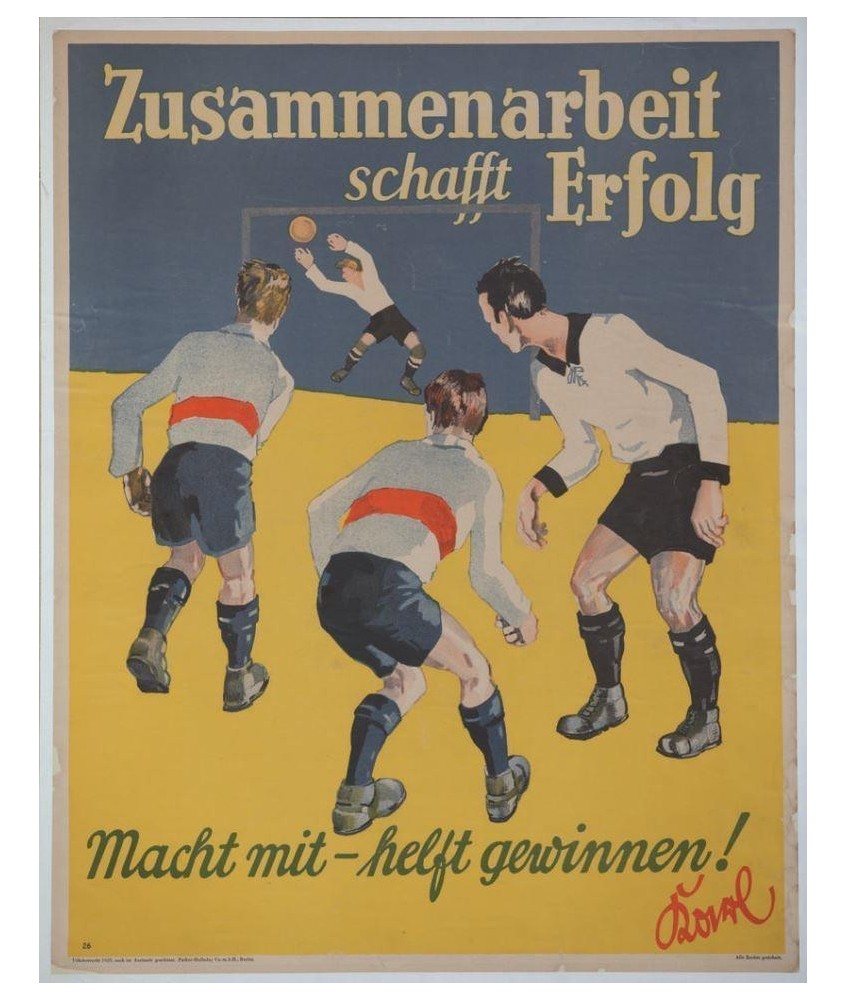


Deux imprimeries (aujourd'hui disparues) - Parker-Holladay Company et Mather & Co. - étaient à la pointe de ce secteur en plein essor de la motivation. Les deux entreprises ont créé une gamme de supports de motivation auxquels les chefs d'entreprise peuvent s'abonner (de nouvelles affiches et de nouvelles cartes arriveront tous les mois), puis raccrocher et distribuer au travail. Les deux sociétés ont embauché certains des meilleurs illustrateurs de l'époque, tels Willard Frederick Elmes et Hal Depuy, pour créer ces magnifiques affiches de motivation.
CLASSEMENT DES AFFICHES SELON LEUR CONSERVATION (en gras celui correspondant à cette affiche):
A+ Parfait état de conservation, très rare trouver un exemplaire dans cet état impeccable.
A Une affiche dans un très bon état de conservation. Il peut présenter une déchirure inestimable et il ne présente pas manque de papier dans les marges. Les couleurs sont fraîches et des taches ne se peuvent pas apprécier.
A- Elle peut présenter une marque légère de pli, de déchirure ou un petit manque de papier dans les marges. S'il présente une restauration, elle est réalisée avec succès.
B+ L’affiche peut être restauré. Les défauts sont légèrement appréciés.
B Une affiche dans un bon état de conservation. Il présente des déchirures, quelques taches et quelques manques de papier, en n'affectant jamais à l'aire cruciale du design. Les couleurs sont fraîches et l’affiche a une apparence générale très bonne.
B- L’affiche est restaurée, on apprécie quelques défauts et une légère perte de couleur dans les marques de pli.
C+ Les restaurations sont visibles.
C Une affiche dans un état de conservation régulier. Il présente des déchirures, des taches, des marques de pli et même des manques du papier qu'il peut partiellement toucher à l'aire cruciale du design, les couleurs peuvent être un peu pâles et l’affiche a une apparence régulière plutôt que bonne.
C- Demande restauration.
Motivational posters…
This new, entrepreneurial definition of manhood reached a peak in the decade before the Great Depression. It was a time of idealism and optimism, and people were bullish both about the future of the economy and people’s ability to change their behavior and develop their character. Pithy maxims were popular (for example, Henry Ford was fond of saying, “Chop your own wood and it will warm you twice”), and it was felt that constructive encouragement could helps folks from any walk of life improve themselves. During this time, businesses began hanging beautifully illustrated posters with the same slogans that authors like Orison Swett Marden shared with readers a decade earlier. There were even trading cards with similar “go get-em” language that were handed out to employees like baseball cards. Business owners hoped that these posters and cards would help boost productivity and morale and inculcate uneducated and immigrant workers with the virile values needed to thrive in the world of business.
Two (now defunct) printing companies — Parker-Holladay Company and Mather & Co. — were at the forefront of this burgeoning motivation business. Both companies created a line of motivational materials that business owners could subscribe to (new posters and cards would arrive each month) and hang up and hand out in the workplace. The two companies hired some of the best illustrators of the day such as Willard Frederick Elmes and Hal Depuy to create these handsome motivational posters.
The Great Depression dealt a serious, if temporary, blow to the Self-Made Man archetype. With the crash in the market, and consequently in morale, the motivational craze fizzled, and the posters produced by Parker-Holladay and Mather & Co. became tattered ephemera that collected dust in antique stores and attics. Recently, however, there’s been a renewed interest in these unique pieces of 20th century history. Traveling exhibitions containing these vintage posters have criss-crossed the country and auction houses are selling them for thousands of dollars.
I can understand the appeal. The vivid artwork and graphic design is top-notch, and while the copy is sometimes ham-fisted, I actually find it inspiring as a man — perhaps because I’m still a believer in the self-made ideal. The advice is pretty timeless and just as applicable today as it was then. The posters teach the sort of stuff your grandpa would tell you: simple, time-tested principles, that if lived, can lead to a life of success.